How to Plant and Grow Globe Amaranth (Gomphrena) | Gardener’s Path
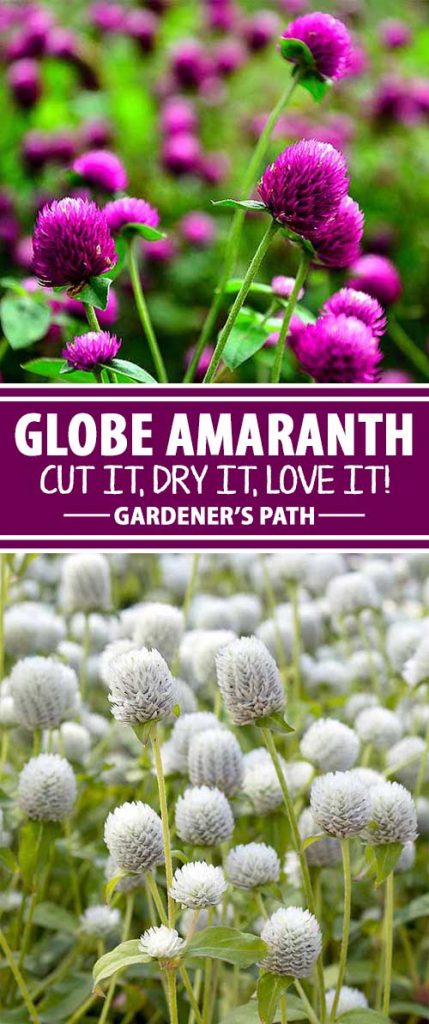
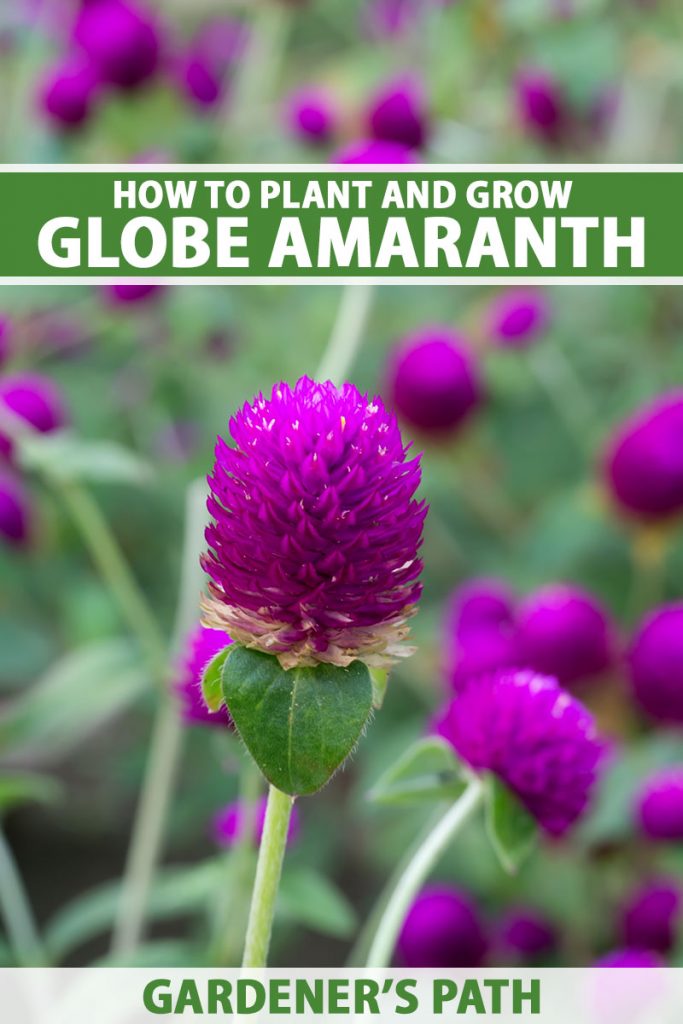
Gomphrena globosa
Globe amaranth is a figurative annual that features protracted-lasting, globe-attribute blossoms in a mixture of colours. Nonpareil for beds, borders, and rock gardens, plants are drought tolerant and suitable for xeriscapes.
In this manoeuvre, we cover wholly you need to cultivate these single, cinnnamon colored flowers in your garden.
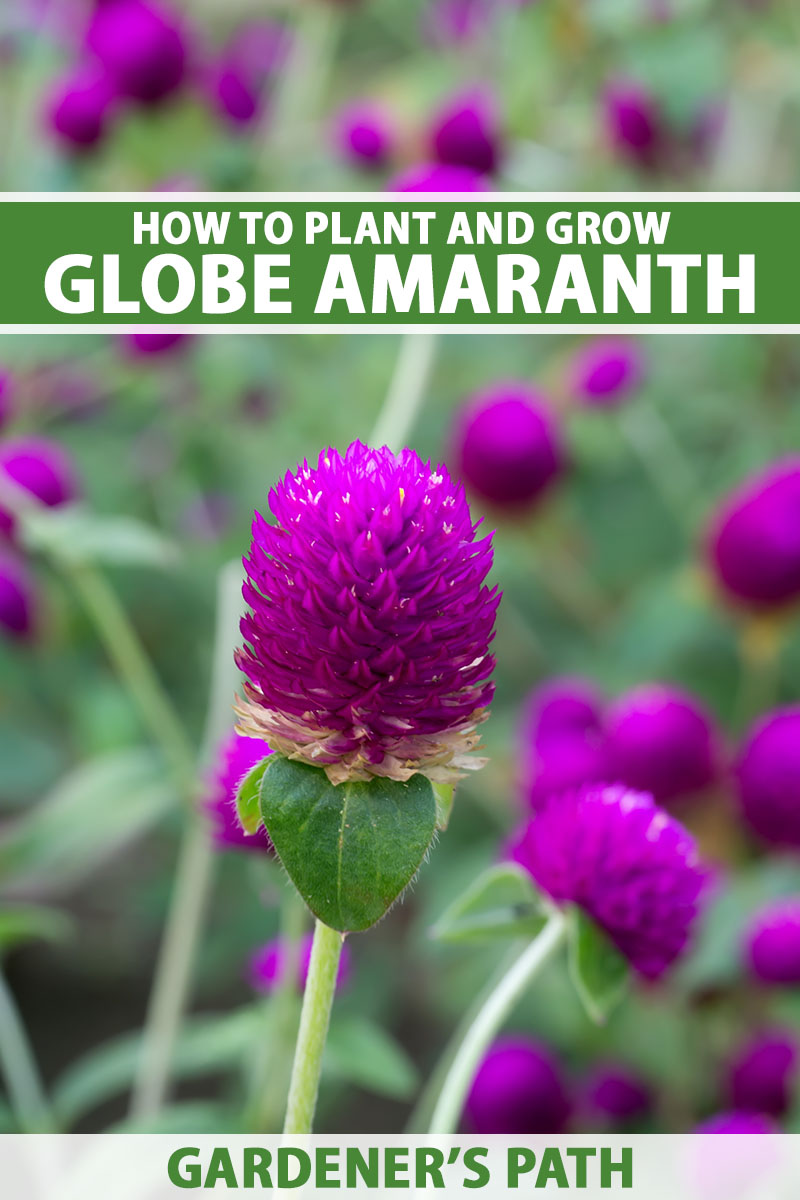
We link to vendors to help you find applicable products. If you buy from one of our golf links, we may earn a commission .
Globe amaranth, Gomphrena globosa, is one of 90 Gomphrena species of flowering plants in the Family Amaranthaceae family.
IT's native to Central and circumboreal South America, where its classical Battle of Magenta blossoms pane the landscape. Attendant plants include love lies bleeding amaranth, cockscomb, and Spinacia oleracea.
The bright flower heads resemble clover, with tubular bracts as an alternative of petals. They are multipotent and papery like those of strawflowers. From each one bract contains a bantam whitened operating theatre scandalmongering bloom that is telescopic at close range.
G. globosa is a tender one-year in Agriculture Hardihood Zones 2 through 8, where it blooms ceaselessly from summer through to the first frost.
In Zones 9 to 11 IT can grow as an one-year and be removed at season's end, operating room it may exist left in the establish to return as a impermanent perennial.
Self-sowing may make additional plants, although seeds take up a low sprouting rate.
Thanks to the magic of hybridizin, flowers are available in an array of colourful dark glasses, including lilac, magenta, garden pink, purple, red, orange, and white.
In this article you'll notic all you want to know to grow and care for bachelor's button in your garden.
What You'll Learn
- Cultivation and Chronicle
- Propagation
- How to Grow
- Growing Tips
- Cultivars to Choice
- Managing Pests and Disease
- Harvest and Protective
- Best Ornamental Uses
- Quick Reference Growing Guide
Let's get started!
Polish and Chronicle
Parallel of latitude by nature, Earth amaranth, aka genus Gomphrena, has a high tolerance for heat and humidity, and craves sunshine.
With its long taproot it has above fair drought tolerance, but prefers concordant moisture, especially during the germination and seedling stages.
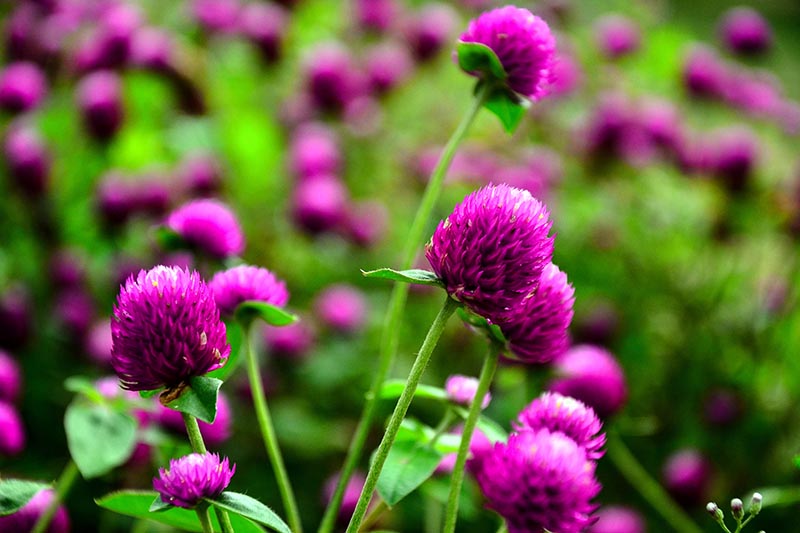
When it comes to soil, it derriere thrive in anything from loam to stiff, provided the drain is excellent.
This is a plant with an upright growth habit that tends to get leggy unless you pinch some flowers archaeozoic in the growing flavor.
There is an array of heights to choose from, equally nowadays's cultivars kitchen stove from cardinal-inch overshadow varieties to giant four-foot specimens.
And patc some may be quite tall, they are concordat plants with spreads of octad to 24 inches.
The upright stems display vertical branching. The leaves are hairy and sometimes have thin purple margins. They grow in pairs opposite one another.
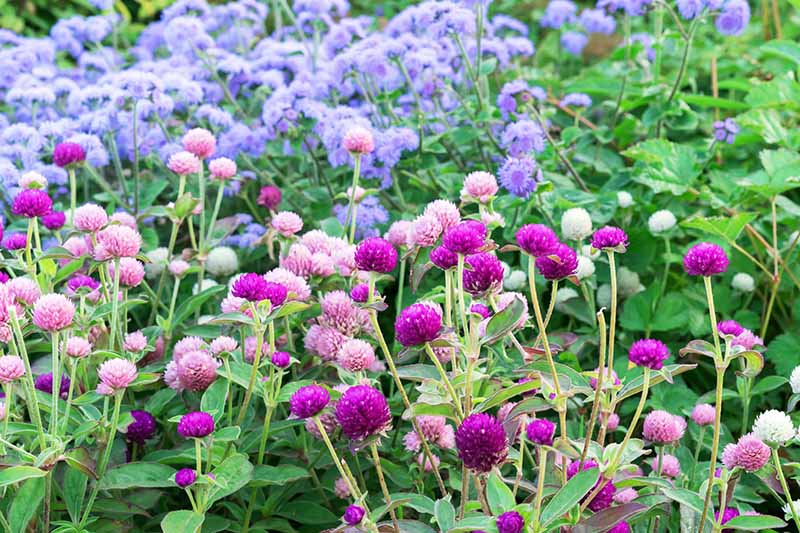
A Earth-attribute flower measurement between one and a half to two inches across blooms at the end of each terminal stem.
A entertaining fact some G. globosa is that it fixes carbon by a C4 pathway.
Huh?
In a nutshell, it's genetically wired to "breathe" differently than many another other plants, so information technology can conserve push, retain wet, and survive in soils lacking in nitrogen that are typical of tropical climes.
The flowers, leaves, roots, and seeds of gomphrena take immune-boosting phytochemicals and antioxidant betacyanins, and have prolonged been victimised by herbalists to savoir-faire an array of ailments ranging from G.I. to respiratory problems.
The plant arrived in the United States in the 1700s. It was grown every bit an ornamental in gardens of the well-disruption, and virtually notably by young Dylan Thomas Jefferson, at his puerility home, Shadwell.
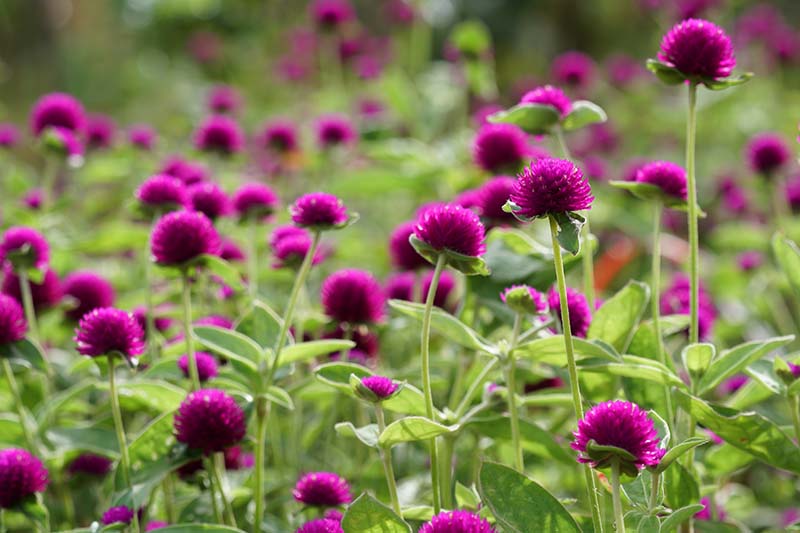
The flowers are a highlight of the gardens at Monticello today.
The blossoms of gomphrena are colorfast, sturdy, and abundant-lasting. They continue to be featured conspicuously in traditional ceremonial garlands in Hawaii, where they are called "bozu," and in Nepal, where they are known arsenic "makhamali ful."
The species is classified American Samoa invasive in Republic of Costa Rica, Cuba, and Hawaii.
Generation
Plants Crataegus laevigata be adult from seeds. Germination is slow, and can take from two to four weeks.
To boot, the rate of germination tends to be low, which way a large proportion of seeds may fail to shoot. Adulthood takes anywhere from 85 to 100 years.
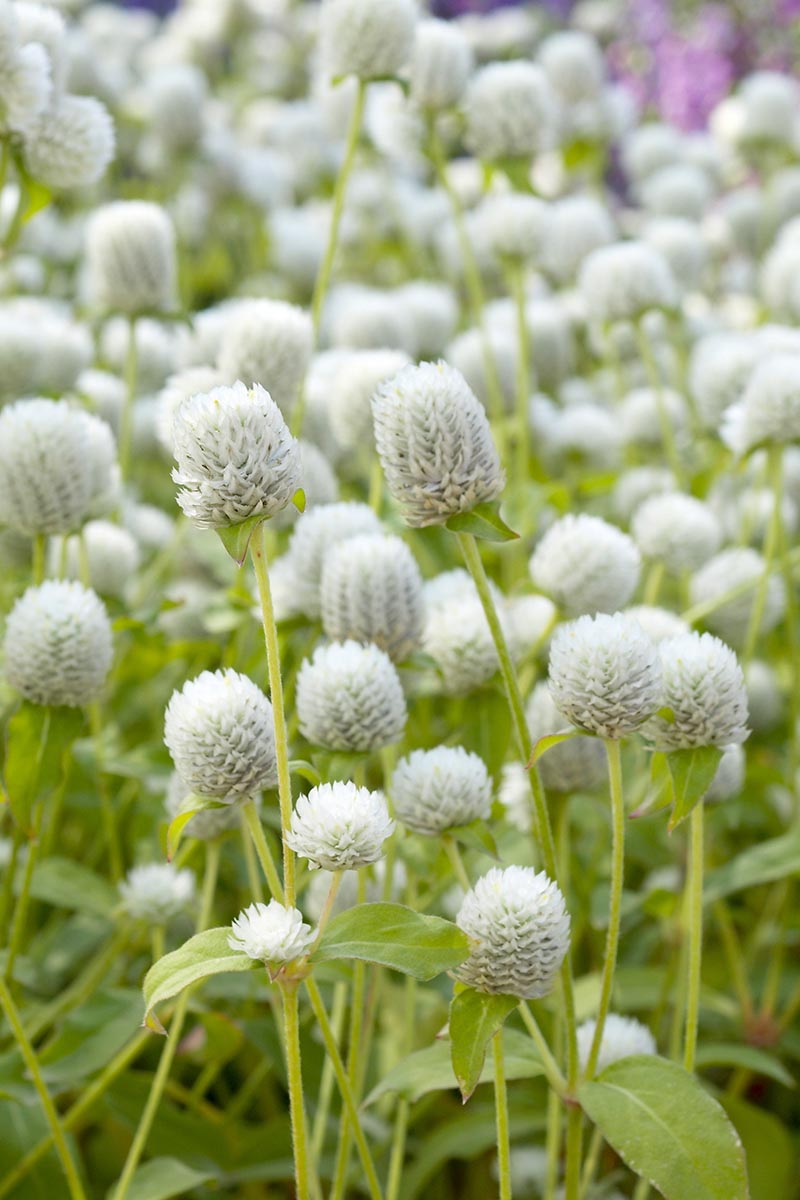
This species has a deep taproot that should be disturbed as little as realistic.
For both recurrent and annual culture, soak seeds overnight and start seeds indoors eight weeks before the dying average spring ice go out to cause a jump happening the growing season.
Use biodegradable seed starter cells or unlifelike bollock cartons that potty be separated for planting. The seeds are tiny, indeed do your best to sprinkle only about cardinal of them into each cell.
Cover them lightly with eighth of an inch of potting medium.
Thin the seedlings to one per cellular telephone when they have got one to ii sets of true leaves.
Subsequently the danger of frost has passed, acclimate the seedlings to the open air by place setting them inaccurate for a few hours each day for three to five days prior to planting them down.
Transplant the individual cells directly into the garden or deep containers after the danger of frost has passed.
For perennial growing, you force out as wel direct sough seeds in the garden, but they Crataegus laevigata non mature and bloom until the back year.
How to Grow
To educate this institut in your garden, wait until the close average frost date for spring has passed before transplanting seedlings. Those who whitethorn direct sow have nobelium frost worries in Zones 9 to 11.
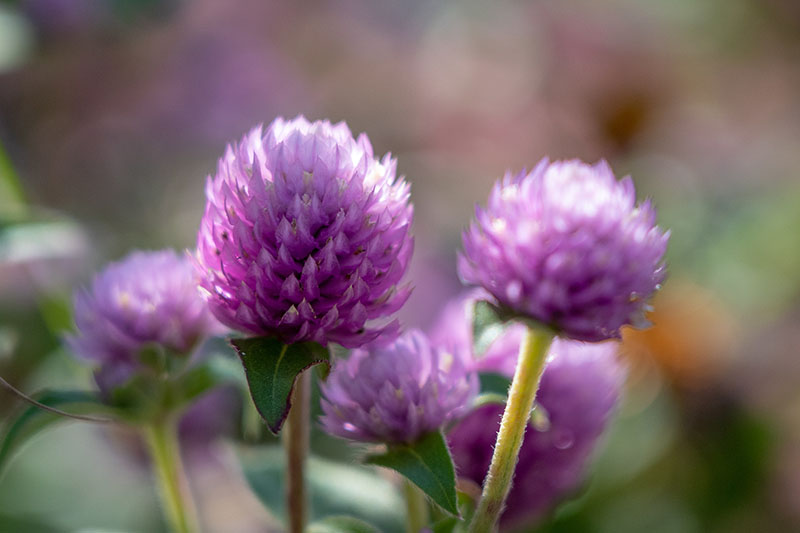
Choose a location in full sun. The soil can roam in choice from organically-rich loam to clay, provided it drains exceptionally well.
Ideally, the pH is in the range of 6.1 to 7.5, or slightly acidic to the barest hint of alkalinity.
To learn about the characteristics of the earth on your property, transmit a colly test through your local cultivation university extension. Adding compost is one right smart to increase acidity, piece mixing in lime reduces it.
Given globe amaranth's long taproot, you'll need to figure out your garden soil to a crumbly consistency to a depth of at any rate 12 inches. Add u amendments as required.
Keep the long taproot in mind when container gardening. The taller the plant, the deeper the pot necessarily to follow. Depths of 12 to 24 inches should be adequate.
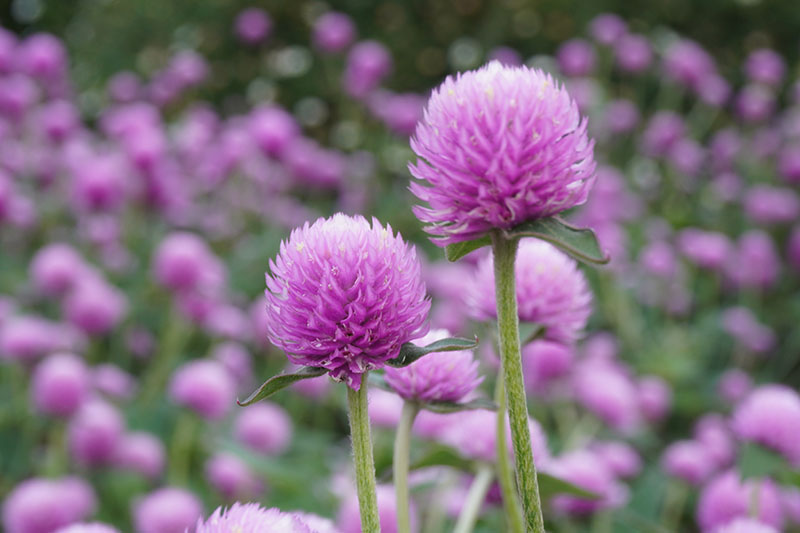
Sow seeds one-eighth of an inch deep. Scatter few all four to six inches and cover them lightly with land.
To transplant thinned out seedlings, cut eggs cartons apart if necessary, and bury individual cells or biodegradable containers in their entirety at the same profundity as the soil in the cells.
It's non inevitable to fertilize. However, if you habitually treat your garden plants to a nourishing dose, make a point to select one that's low in nitrogen, or you may recover that you get scores of leaves and some flowers.
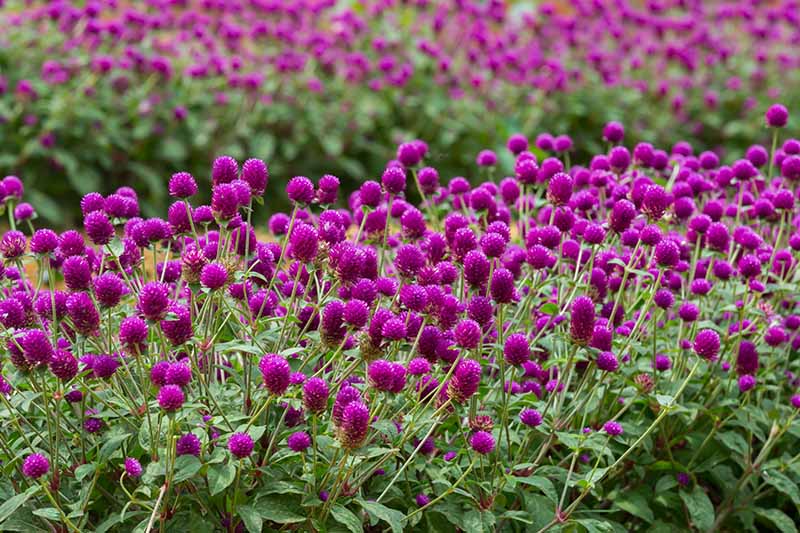
Maintain straight wet, but don't overdo it. Oversaturation can make sprouts prone to "damping remove," a fungal disease that causes them to flop terminated and expire.
When the seedlings have unity to cardinal sets of literal leaves, thin them out to a spacing of 12 to 18 inches. Good airflow also aids in inhibiting plant disease.
Equally plants mature, provide no to a higher degree one inch of water per week through a combination of rain and secondary lachrymation.
Always bearing the hose surgery watering can at the soil, not the leaves, to inhibit fungal growth.
When you see the first flower buds forming, you can pinch them off to encourage bushier growth. Long-legged plants may expect staking.

Throughout the growing season, periodically deadheading or cutting flowers for arranging serves not but to inhibit long-legged growth, simply to advance further blooming.
For best results, cut a portion of a stem, not conscionable a flower head, at a point where it meets another stem, or where two leaves meet.
Every bit a tropical plant, gomphrena loves heat, but requires moisture. And patc it withstands drouth bettor than some plants, it thrives best under conditions that mimic the tropics.
Growing Tips
Now that you're every last countersink to spring u your own plants, let's recap much key points before we continue:
- Seeds are delayed to germinate; seed extra and thin later.
- This is a tropical plant, not a desolate one, and then while it loves heating, information technology needs consistent moisture.
- Fertilizer isn't necessary and may lead to an overproduction of leaves.
- Respect the deep taproot with little ruffle and deep containers.
Cultivars to Select
Choosing polite varieties of G. globosa is fun because there are then many colours and sizes available.
Here are a few to ponder:
Audray White
'Audray White' boasts cold white blooms atop 18-edge stems.
This mid-size variety is well-suited to middle placements in beds and borders, too as containers.
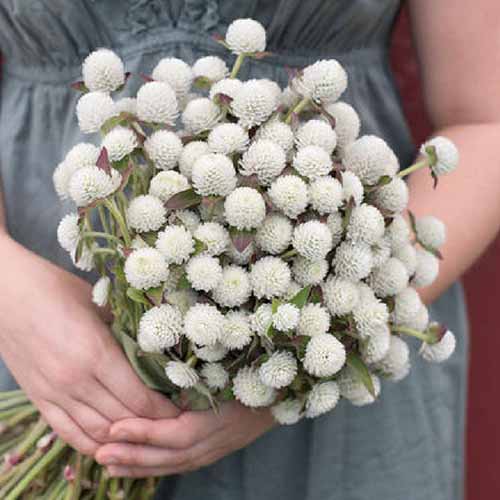
'Audray White'
Its amoral tone makes it a great buffer between plants of different shades and a visually catchy companion to all.
Find packets of 50 seeds from David's Garden Seeds Store via Amazon.
Fireworks
If you're looking to impress, giant 'Fireworks' tops out at 36 to 48 inches and may just be the one you're look for.
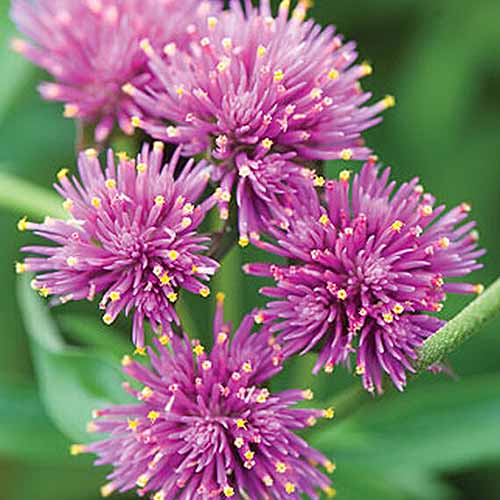
'Fireworks'
With new pink bracts and tiny, merely highly viewable dishonourable flowers, this is your choice for a specimen planting to capture the attention of passersby.
You can find a ready of foursome starter plants surgery a packet of 30 seeds available at Burpee.
Mixed Dwarf
This grab purse of pink, purple, and white heterogenous 'Gnome' flowers flower on low-profile plants that top out at a petite sestet inches.
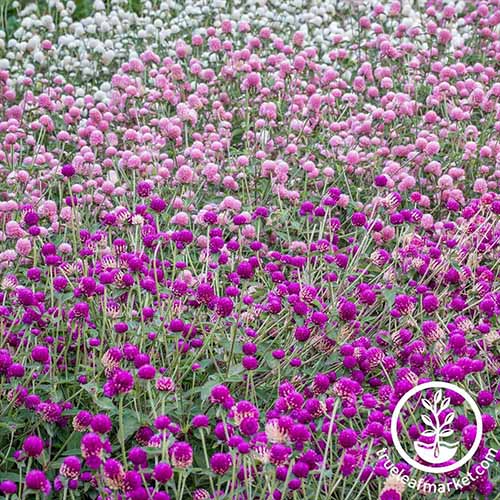
'Dwarf'
Perfect for small containers and fronts of borders, these cotton glaze sweethearts are dependable to please.
Find mixed 'Gnome' seeds in packets of 1,000 available from True Leaf Grocery store.
Managing Pests and Disease
G. globosa is not peculiarly inclined to pests and disease, and with best gardening practices you should have fewer to none.
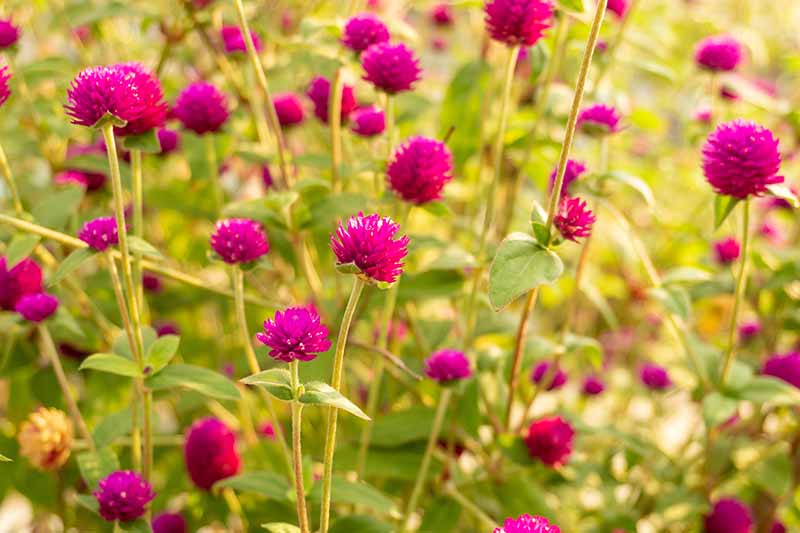
However, there are several blackjack-sucking insects that not only destroy foliage with their voracious eating habits, they lav besides be carriers of disease.
Two pests to watch out for are:
- Aphids
- Thrips
If you stern't get rid of them with a immobile spray from the garden hose, an application program of organic neem oil should do the trick.
As for disease, the following conditions may present themselves when conditions are to a lesser degree ideal:
- Alternaria Leaf Spy
- Botrytis Blight, aka Gray Mold
- Damping Off
- Fine-grained Mildew
Alternaria leaf spot causes dead brown patches circular in yellow happening ripen leaves. Unchecked, entire leaves curl and brownness before demise and dropping. Discard affected leaves in the trash and apply a fungicide.
Botrytis blight and powdery mildew are plant diseases that damage foliage by infecting them with grayish, fuzzy mold.
Treat some by picking unsatisfactory and disposing of affected substantial in the trash and applying a fungicide.
Damping off, as discussed in the growing section, is a fungal disease that can dispatch oversaturated sprouts and drive them to literally keel over and die. It is incurable.
To avoid infestation and transmission represent careful to:
- Plant in full sun, non only for beautiful, sun-loving blooms, but to keep open foliage from staying wet and attractive fungal development.
- Follow spacing recommendations when planting. Good flow of air inhibits moisture buildup and fungal conditions.
- Weed the garden regularly to deter pests from making your garden their home.
- Water at the soil level to keep from oversaturating foliage and devising information technology fungus-prone.
- Don't overwater. Maintain wet, but don't oversaturate, particularly at the seedling stage.
When you grow gomphrena as an ornamental specimen, foliage affected by pests and/or disease is non pretty, but when you catch it and treat it, the flowers Crataegus oxycantha be just fine.
If you are cultivating plants as edibles, you will pauperization to be extremely vigilant when it comes to not overwhelming infested operating theater infected material, as well as using only treatment products that are knowing for use on edibles.
And along that note, information technology's time to discuss picking and using flowers, leaves, seeds, and even roots for ornamental purposes operating theater use.
But before we do, rent out Pine Tree State recommend proceeding with caution when consuming a implant merely because it is pabulum. All foods don't jibe with all people, so if you take allergies or other health conditions, please consult your Greco-Roman deity practitioner for guidance before experimenting.
Harvest and Preserving
Globe amaranth is broadly speaking grown as an ornamental plant; still, as the tender sprouts, boylike leaves, flowers, roots, and seeds are edible, they are all target for harvesting, if you're indeed leaning.
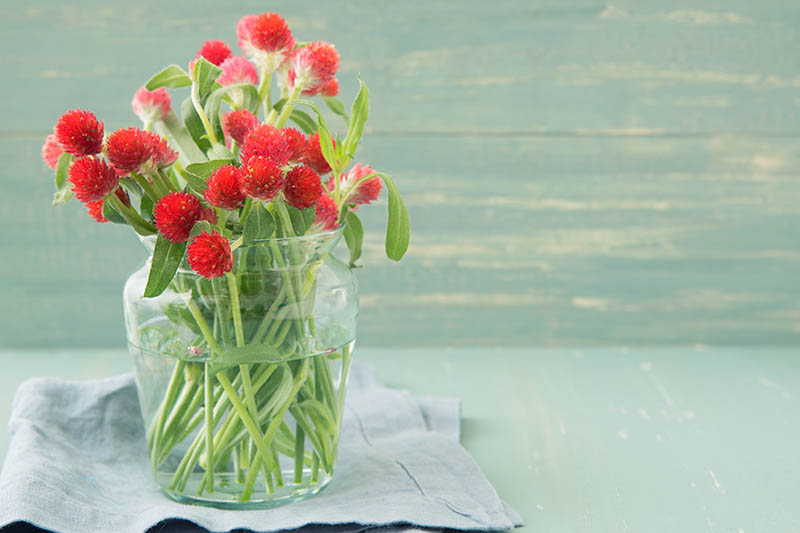
In addition, the intense color of the traditional magenta blossom makes a lovely natural food dye.
You tooshie pick the sprouts to eat arsenic microgreens, and the sentimental young leaves earlier they get fuzzy and tough.
Harvest time flower heads as coveted by pinching them disconnected at the lowly of their stems, where they adjoin other base operating room pair off of leaves. Select those that are almost, but non quite a, fully open.
At the end of the growing flavour, you tin harvest both roots and seeds.
To harvest the roots, dig the plant risen when information technology has finished crashing, and before the first frost.
Trimmed the stems off at the crown.
Rinse off the soil off the roots before use.
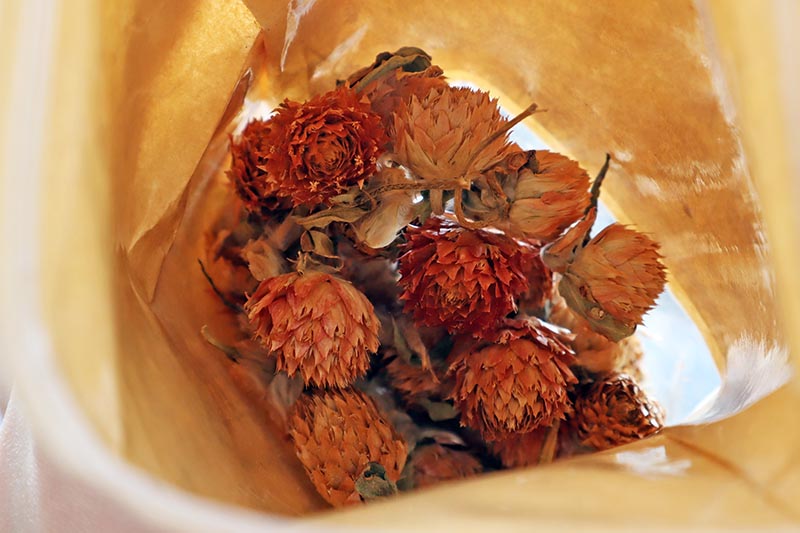
To harvest the seeds, wait until the flower heads are dry and tan in color. Cut bac them off and pull them unconnected over a light colored cloth for better visibility, releasing them and separating them from the banter as you lead.
If you are gathering them to sow next year, delight note that the seeds from hybrid plants are not always viable, and when they are, are likely to give rise surprising traits that don't necessarily resemble those of parent plants.
Flakey sprouts and young leaves should comprise exhausted as soon every bit possible after picking, so toss them onto your lunch period salad, Beaver State into a simmering stew for the dinner crowd.
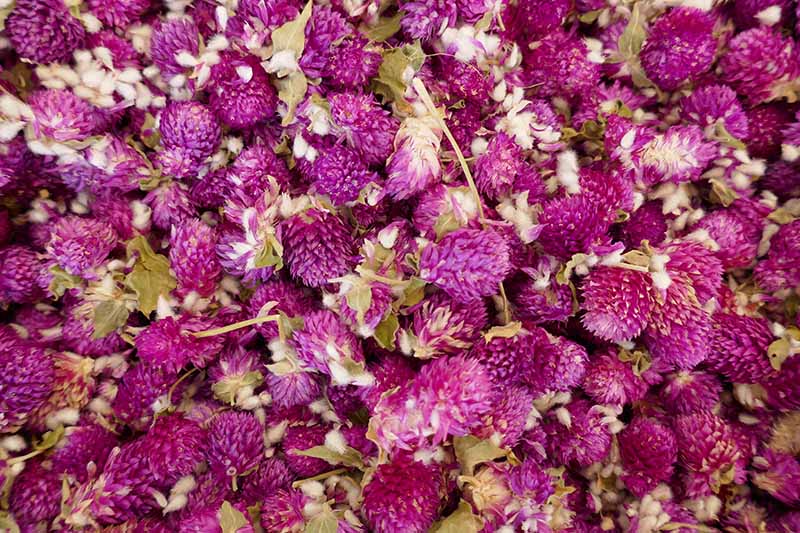
Fresh flowers should also be used right away. They bring i jolly garnishes surgery an stuff tea when brewed.
To prohibitionist flowering stems at their peak of color:
Cut the stems as soon as the flowers to the full open. Include those in the bud or half-open stage, if you like. Avert flowers that are beginning to lose their color and run to seed.
Whether you remove OR go out the foliage attached is solely aweigh to you.
Gather up the stems look-alike a fragrance.
Bind them with twine, departure long ends for suspending them from a snitch or nail down.
Hang them upwardly top side down pat, and allow them to dry for three to cardinal weeks. The stems and leaves will turn dark-brown, but the flowers volition retain their vibrant hues.
Use full stems in floral arrangements, and lop some flower heads off to add color to smorgasbord sachets, brew into tea, or to make natural dyestuff.
Dry flower heads should keep for a twelvemonth in an tight jar. As with seeds, if they appear to spoil, discard them.
Edible roots are generally consumed as other root vegetables, equivalent carrots. Depending upon their thickness, they may last a fewer years in the electric refrigerator before becoming limp and unappealing.
Dry seeds should keep off well for a year in an airtight jar. If discoloration, mold, or odor go on, discard them.
Best Decorative Uses
Available in sizes ranging from six-inch dwarf varieties to four-foot giants, the close-packed nature and continuous bloom of G. globosa make IT perfect for beds, borders, pots, rock gardens, xeriscapes, and windowpane boxes that get full sun.
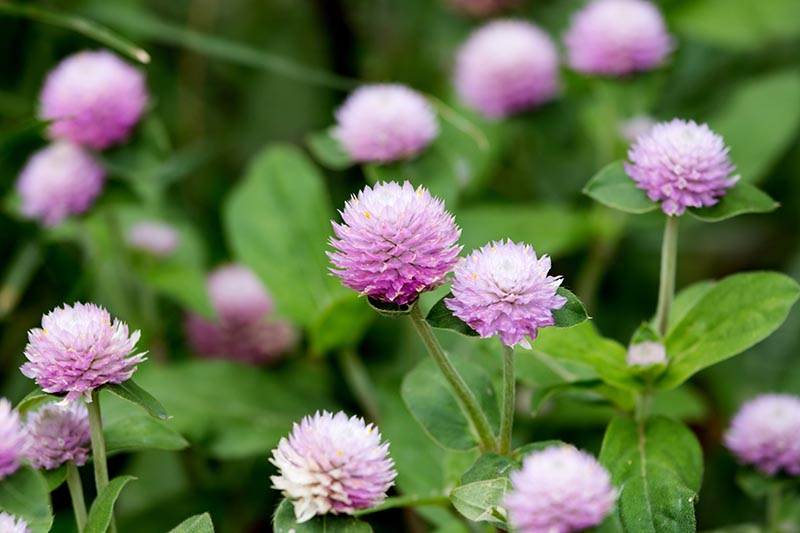
To boot, the taller varieties make great cutting flowers for summer and fall centerpieces, and every sizes dry beautifully for use in wreaths and everlasting arrangements.
If you're growing in containers, be sure enough they have satisfactory drain holes before filling with potting dirty.
Wherever you find them a home, these sturdy, bold blooms are sure to pop with color. Attempt pairing them with these plants that share related social requirements:
- Celosia
- Marigold
- Mexican Petunia
- Salvia
- Old maid flower
With G. globosa in the garden, you're sure to pull bees, butterflies, and other good pollinators to all the plants that grow there.
Quick Reference Growing Guide
| Plant Type: | Tender flowering period of time, short-lived perennial | Bloom / Foliation Semblance: | Lilac, magenta, pink, purple, red, orange, Andrew Dickson White/green |
| Native to: | Central and northern South America | Maintenance: | Low |
| Hardiness (Agriculture Zone): | 2-11 | Tolerance: | Deer, drouth, poor soil |
| Bloom Meter: | Summertime-frost | Soil Type: | Average |
| Exposure: | Full sun | Land pH: | 6.1-7.5 |
| Spacing: | 12-18 inches | Grease Drainage: | Well-draining |
| Planting Depth: | 1/8 inch | Attracts: | Bees, butterflies, and other pollinators |
| Height: | 6-48 inches | Companion Planting: | Celosia, marigold, Mexican petunia, sage, old maid |
| Spread: | 8-24 inches | Uses: | Beds, borders, containers, cutting, drying, rockeries, xeriscapes |
| Emergence Rate: | Slow | Family: | Amaranthaceae |
| Water Inevitably: | Medium | Genus: | Genus Gomphrena |
| Common Pests and Disease: | Aphids, thrips; Botrytis blight, Cercospora leaf spot, damping dispatch, gray stamp, powdery mildew | Species: | Globosa |
Square-shouldered and Everlasting
Here in the Northeastward, for my money, G. globosa is a great investment funds in an annual plant because it infuses my summer-to-hoar gardens with richly saturated color and texture.
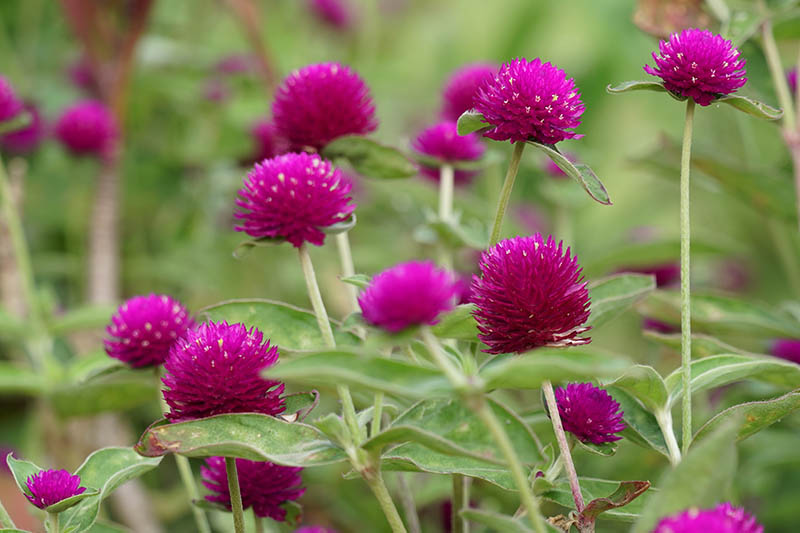
And, I especially enjoy arranging flowers and leafage from the backyard that get into't equitable attend large fresh, but retain their reverberant color even when dehydrated.
It's time to take outgoing your garden planner and decide where you're going to plant globe amaranth. Whether arsenic an ornamental or edible, it's sure to peppiness upfield existing spaces with its multitudes of cheery blooms.
Have you had success with Gomphrena globosa at your house? Tell us about your experience with this ceaselessly flowering annual in the comments segment below.
And for more information on growing flowers in your garden, check forbidden these guides next:
- How to Rise Astilbe Flowers: A Shade Nurseryman's Best Admirer
- How to Grow and Worry for Gladiolus
- How to Establish and Grow Sea anemone Flowers
https://gardenerspath.com/plants/flowers/globe-amaranth/
Source: https://gardenerspath.com/plants/flowers/globe-amaranth/
0 Response to "How to Plant and Grow Globe Amaranth (Gomphrena) | Gardener’s Path"
Post a Comment